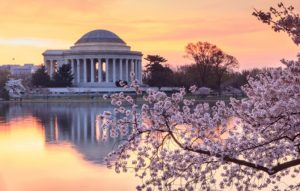
Unfortunately, this year’s National Cherry Blossom Festival had to cancel and postpone events due to the current COVID-19 situation.
However, we can expect this annual event to return in 2021. Learn more about this festival’s origins and how to plan for your 2021 trip to D.C. for next year’s springtime celebration!
Stay safe!
This year we will miss the National Cherry Blossom Festival, an annual celebration that attracts many to the beautiful trees and delicate flowers in Washington, D.C. Due to the coronavirus outbreak, much of the festivities have been cancelled as of this writing. The good news is that the trees and the festival are an annual event, and we all can look forward to their return next year! As Maryland residents, we enjoy close proximity to this traditional spring gathering, which has grown and expanded over the years. Yet, with all fun, food and great photo ops, many of us know little of the history of the festival or the trees. Where did these cherry trees come from, and how did the Festival become what it is today?
How It All Began
The dreamy, pink-petaled trees didn’t always transform our nation’s capital into a picturesque springtime destination. The Yoshino Cherry trees aren’t native to the United States. Bringing these lovely trees to Washington, D.C., started more than 100 years ago. In 1885, Eliza Ruhamah Scidmore, the first female board member of the National Geographic Society, requested that these trees be planted along the Potomac River. When her requests were ignored, Scidmore campaigned to raise funds to purchase the cherry trees and donate them to D.C. After outlining her plan in a letter to then-First Lady Helen Herron Taft, she gained the first lady’s support. Soon after, the first lady accepted a donation of 2,000 cherry trees from visiting Japanese chemist Dr. Jokichi Takamine. Unfortunately, The Department of Agriculture found the January 6, 1909 shipment of trees infested with bugs and disease, so they were subsequently destroyed to prevent the spread to the local ecosystem.
A second donation, suggested by the Japanese government, was received on March 26, 1912. More than 3,000 cherry trees were planted along the Tidal Basin in West Potomac Park. The United States reciprocated this generous gift by sending flowering dogwood trees to Japan.
Later on, in 1965, the Japanese government made another donation to First Lady Lady Bird Johnson of over 3,000 trees. Those trees were planted on the grounds of the Washington Monument.
Schools would reenact the planting of the trees along with other activities, holding the first “festival” in 1927. The National Cherry Blossom Festival would grow over the years to span weeks, in order to accommodate the iconic blooming period for all to enjoy.
What it Means Today
The Festival celebrating the beloved cherry trees means several things. Mostly, the annual event celebrates Japan’s and the United States’ friendship. In the local area, it has come to mean a celebration of springtime’s arrival, as the blossoming buds symbolize renewal and life. The Festival now also serves as an opportunity for involving the community in traditional and contemporary arts and cultural activities.
Where the Trees Are
The majority of cherry trees are near the Tidal Basin. However, several clusters of trees can be found along the National Mall, the Lincoln Memorial, near the Washington Monument, and several other locations throughout D.C. Apart from the trees themselves, the many activities and events that are held during the Festival can be found throughout the area as well.
For more information to learn more and begin to plan your 2021 trip, visit the National Cherry Blossom Festival official website!
Design and Build Your Dream Home with Columbia Builders!
Columbia Builders is the home builder of choice in Howard County, offering homes in Ellicott City, Elkridge, Laurel, Columbia, Marriottsville, Fulton, Clarksville, Dayton, and Brookeville. No matter what the size and scope of your project, we have the skills, experience, and resources needed to bring your vision to life. We offer a level of customization that is truly unmatched and are committed to using materials and craftsmen of the highest quality, so you can trust that your new home is built to last.
If you’re ready to invest in a home, built with your needs in mind, trust in us. Give Columbia Builders a call today at 410-730-0215 or use our contact form here. You can also keep up with us on Facebook, Twitter, Houzz, and Youtube, and don’t forget to check back on our blog for more tips and information!
